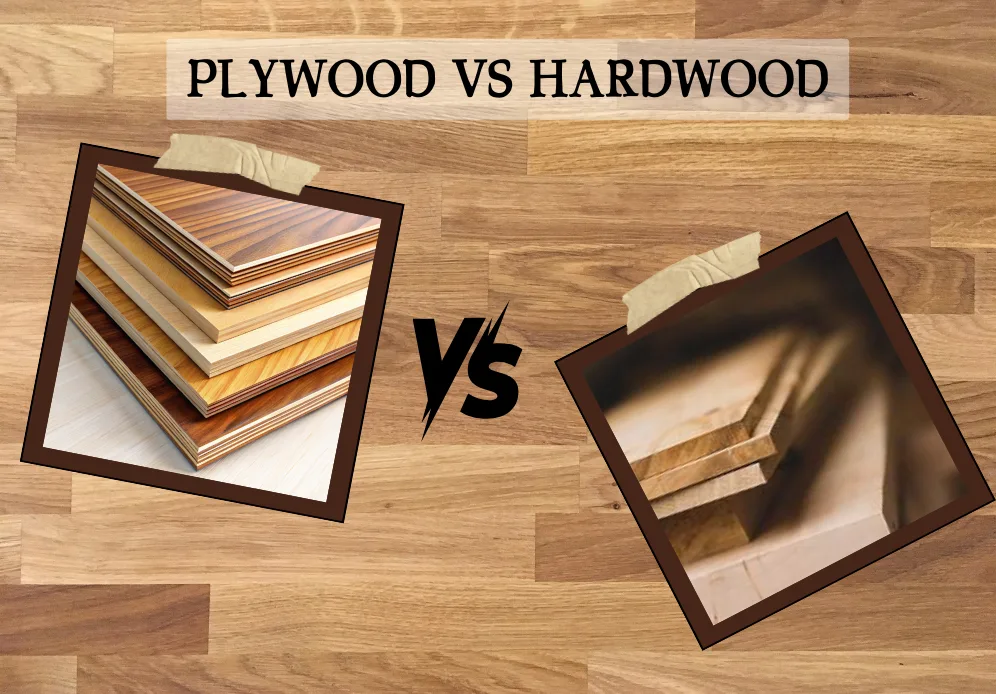When choosing between plywood vs hardwood, the decision isn’t always easy. Both materials have their unique benefits and are suited for different projects. Understanding the differences, benefits, and limitations of each can help you make the best choice for your needs.
What Is Plywood?
Plywood is a versatile engineered wood product made by gluing together multiple thin layers of wood veneer. These layers, known as plies, are pressed together in alternating grain directions, which adds to the strength of the material.
Plywood is available in various grades, depending on its intended use. It’s a popular option from construction to furniture making due to its affordability, strength, and resistance to warping.
What Is Hardwood?
Hardwood comes from deciduous trees like oak, maple, and walnut. These trees lose their leaves annually, and the wood produced is dense, durable, and long-lasting. Hardwood is often prized for its natural beauty, strength, and grain patterns. It’s commonly used in flooring, fine furniture, and cabinetry.
Though hardwood is more expensive than plywood, its durability and aesthetic appeal make it a favorite in high-end projects.
Key Differences Between Plywood vs Hardwood
Understanding the distinctions between plywood vs hardwood will help you select the best option for your project.
1. Composition
- Plywood: Engineered wood made by bonding thin layers of wood veneer.
- Hardwood: Solid wood cut directly from hardwood trees.
2. Strength and Durability
- Plywood: Strong and stable but depends on the grade and number of plies. It may not be as durable as hardwood in the long term.
- Hardwood: Extremely durable and stronger than plywood. It can last for decades with proper care.
3. Cost
- Plywood: Generally more affordable and cost-effective for large-scale projects.
- Hardwood: Hardwood is more expensive due to its natural origin, processing, and limited supply.
4. Appearance
- Plywood: Available in various finishes but often requires a veneer to mimic hardwood’s appearance.
- Hardwood: Naturally beautiful with rich grains and textures. Each piece has unique visual characteristics.
5. Uses
- Plywood: Ideal for structural elements, subflooring, and budget-friendly furniture.
- Hardwood: Best suited for high-end furniture, flooring, and cabinetry where aesthetics and longevity are important.
Advantages of Plywood
Plywood has several advantages, making it a go-to material for various projects.
1. Affordability
One of the most significant benefits of plywood is its cost. It’s much cheaper than hardwood, making it ideal for large projects that require vast amounts of material.
2. Strength in Layers
Thanks to its layered structure, plywood is incredibly resistant to cracking, warping, or shrinking. This makes it more stable for applications like roofing, subflooring, and walls.
3. Lightweight
Compared to hardwood, plywood is relatively lightweight. This makes it easier to handle, transport, and install, especially for DIY projects.
4. Versatility
Plywood comes in various thicknesses and grades, giving you a wide range of options depending on your project. Whether you’re building cabinets, making furniture, or using it for construction, plywood can be tailored to fit.
Advantages of Hardwood
While plywood is great for many applications, hardwood shines in areas where aesthetics, strength, and longevity are priorities.
1. Aesthetic Appeal
Hardwood has a natural beauty that plywood cannot match. Its unique grains, textures, and colors make it the preferred material for high-end furniture and flooring. Over time, hardwood can also develop a lovely patina, adding to its visual charm.
2. Durability
Hardwood is stronger than plywood and lasts significantly longer. It can withstand heavy foot traffic, making it ideal for flooring. Its durability ensures that furniture and structures made from hardwood stand the test of time.
3. Resale Value
Homes with hardwood flooring or custom hardwood furniture tend to have higher resale values. Its lasting appeal and durability make it a wise investment for those looking to increase the value of their home.
Choosing Between Plywood vs Hardwood: Which is Better?
Ultimately, the decision between plywood vs hardwood depends on your project’s needs, budget, and aesthetic preferences.
- Choose Plywood if you’re working on a large-scale project, need to save on costs, or don’t require a high-end finish. Plywood is strong, affordable, and versatile enough for most applications.
- Choose Hardwood if aesthetics, longevity, and strength are priorities. Hardwood is perfect for projects that need to stand the test of time and add beauty and value to your home.
Conclusion
When considering plywood vs hardwood, the choice ultimately depends on your project’s needs, aesthetic goals, and budget. Plywood is a cost-effective, versatile option that works well for structural elements and furniture. On the other hand, hardwood offers unmatched beauty, durability, and value for high-end projects.
By understanding the key differences, strengths, and limitations of each material, you can confidently choose the right one for your next project.
Frequently Asked Questions (FAQs)
Which Is More Affordable, Plywood Or Hardwood?
Plywood is generally more affordable than hardwood. Hardwood is more expensive due to its natural beauty and durability.
Is Plywood As Strong As Hardwood?
While plywood is strong, hardwood is more durable and long-lasting. Plywood’s layered construction gives it stability, but hardwood’s density offers greater strength.
Can Plywood Be Used For Furniture?
Yes, plywood is often used in budget-friendly furniture and cabinets. It can be finished with veneers to mimic the hardwood’s appearance.
How Does Hardwood Compare To Plywood For Flooring?
Hardwood is the preferred option for flooring due to its durability and aesthetic appeal. Plywood is more commonly used as subflooring.
Which Is Easier To Work With Plywood Or Hardwood?
Plywood is generally easier to handle and work with due to its lightweight nature. Hardwood can be heavy and may require specialized tools.

